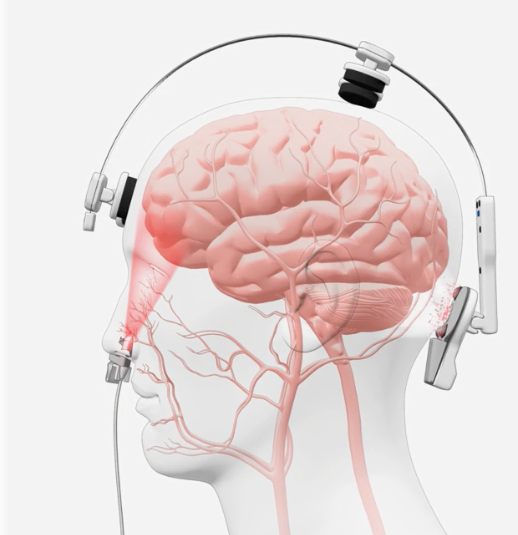
Photobiomodulation therapy uses non-ionizing electromagnetic energy to trigger photochemical changes in cellular structures that are susceptible to photons. Mitochondria, intracellular energy stations, are especially susceptible to this process. They absorb energy from visible red and near infrared light and produce cellular energy in the form of the chemical ATP, which drives biochemical reactions in cells. The key to this whole process is the mitochondrial enzyme cytochrome oxidase C, which accepts photon energy of specific wavelengths.
Near infrared light, penetrating into the mitochondria of the brain through the cranial bone (transcranially), stimulates mitochondrial respiration in neurons, giving off photons that are absorbed by cytochrome oxidase. This bioenergetic process is called photoneuromodulation. The absorption of light energy by the enzyme leads to an increase in the enzymatic activity of brain cytochrome oxidase and activation of oxygen consumption, which has a positive effect on metabolic processes in nerve cells, reduces inflammation and oxidative stress and stimulates the appearance of new cells (neurogenesis), has a protective (neuroprotective) effect and inhibits neurodegeneration processes .
As a result of such an impact on the brain, its cognitive (mental) functions are improved, depression and anxiety are reduced, and the consequences of traumatic and age-related brain damage are reduced. It has been shown to have a positive effect on heart function, reducing pain, stiffness and fatigue in fibromyalgia, rheumatoid arthritis, osteoarthritis and other types of chronic pain. Encouraging results have been obtained in diabetes, parkinsonism, PTSD, Alzheimer's disease.
Another area of promising application of photobiomodulation is the stimulation of the thymus gland, which plays an important role in immunity. Depressive conditions are often accompanied by various disorders in the functioning of the immune and endocrine systems, in particular, hyperactivity of the hypothalamus-pituitary-adrenal system and an increase in the blood levels of the stress hormone cortisol (which confirms the stressful nature of depression). As a result, the secretion of thymic hormones decreases, thymus atrophy occurs, immunity and resistance to infections decrease, dormant viral and bacterial infections reactivate.
Our center uses a photobiomodulation device from the leading US manufacturer Vielight, which directs infrared light at a wavelength of 810 nm (near infrared) to the brain. Simultaneously, red light with a wavelength of 633 nm is delivered through a light-emitting diode in the nasal applicator. In total, the therapeutic effect is on a large part of the brain. The other applicator directs 810 nm infrared light to the thymus area.
Scientific articles about photobiomodulation:
Department of Medical Physics, Tabriz University of Medical Sciences
Wellman Center for Photomedicine, Massachusetts General Hospital
Wellman Center for Photomedicine, Massachusetts General Hospital
Department of Neurology and Neurotherapeutics, University of Texas
